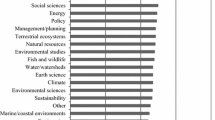Abstract
Environmental exposure to chemicals associated with modern industrial and agricultural practices is a major societal concern. Evaluating and managing risk from these chemicals requires knowledge based on both the natural and the social sciences. In this study, we investigated if students studying in environmental programs are acquiring the technical expertise, or focused preparation in risk sciences, to actively participate in risk assessment. Among programs with faculty associated with the Association of Environmental Studies and Sciences, we found that comprehensive preparatory coursework directed toward risk assessment was not a common feature among most programs. Preparation in statistics was evident among all degree programs, and those programs awarding Bachelor of Science degrees generally required foundational coursework in the natural sciences. Required coursework was rarely directly related to the risk sciences or toxicology. As a group, program graduates would not have acquired through their environmental program foundations central to the risk assessment processes. However, as shown in the analysis presented here, sufficient variation exists both among and within programs to anticipate that many individual graduates could have this preparation and make active contributions.

Similar content being viewed by others
References
Bootsma M, Vermeulen W, van Dijk J, Schot P (2014) Added value and constraints of transdiscipllinary case studies in environmental science curricula. Corp Soc Responsib Environ Mgmt 21:155–166
Cooke SJ, Vermaire JC (2015) Environmental studies and environmental science today: inevitable mission creep and integration in action-oriented transdisciplinary areas of inquiry, training and practice. J Environ Stud Sci 5:70–78
Education TC (2013) Chronicle of Higher Education. Retrieved July 15, 2015, from What is College For: http://chronicle.com/article/What-Is-College-For-/138683/
Gennings C, Ellis R, Ritter JK (2012) Linking empirical estimates of body burden of environmental chemicals and wellness using NHANES data. Environ Int 39(1):56–65
Haines D, Murry J (2012) Human biomonitoring of environmental chemicals—early results of the 2007–2009 Canadian Health Measures Survey for males and females. Int J Hygiene and Environmental Health 215(2):133–137
Proctor JD (2015) Theory in, theory out: NCSE and the ESS curriculum. J Environ Stud Sci 5:218–223
Roy ED, Morzillo A, Seijo F, Reddy SM, Rhemtulla JM, Milder JC, Martin SL (2013) The elusive pursuit of interdisciplinarity at the human-environment interface. Bioscience 63(9):745–753
Sandman P (1987) Risk communication: facing public outrage. EPA J 21–22
Slovic P (1987) Perceptions of risk. Science 236(4799):280–285
Soule ME, Press D (1998) What is environmental studies? Bioscience 48(5):397–405
Surren MS, Davis K, Liang CL, Adlard B, Foster WG, Donaldson SG, Oostdam JV (2014) Comparing plasma concentrations of persistent organic pollutants and metals in primiparous women from northern and southern Canada. Sci Total Environ 479–480(May):306–318
U.S. Department of Health and Human Services (2015) Fourth National Report on Human Exposure to Environmental Chemicals Updated Tables. Retrieved September 16, 2015 from http://www.cdc.gov/exposurereport/
USEPA, S. P (2000) Risk characterization handbook. EPA 1-B-00-002.
USEPA (2010) Exposure assessment tools and models. Retrieved July 20, 2015, from http://www.epa.gov/oppt/exposure/pubs/exposurep.htm
USEPA (2012a) Human health risk assessment. Retrieved July 15, 2015, from http://www.epa.gov/ncea/risk/health-risk.htm
USEPA (2012b) Human health risk assessment. Retrieved September 16, 2015 from http://www.epa.gov/risk_assessment/health-risk.htm
USEPA (2015) Guidance and reports. Retrieved September 16, 2015 from http://www.epa.gov/riskassessment/guidance.htm
Vincent S, Focht W (2011) Interdisciplinary environmental education: elements of field identity and curriculum design. J Environ Stud Sci 1(1):14–35
Vincent S, Bunn S, Sloane L (2013) Interdisciplinary environmental and sustainability education on the nation’s campuses 2012: curriculum design. National Council for Science and the Environment, Washington, D.C
Author information
Authors and Affiliations
Corresponding author
Rights and permissions
About this article
Cite this article
Silverman, G.S., Wally, M.K. Preparation of environmental studies and sciences students to participate in the environmental risk dialogue. J Environ Stud Sci 6, 580–588 (2016). https://doi.org/10.1007/s13412-015-0331-z
Published:
Issue Date:
DOI: https://doi.org/10.1007/s13412-015-0331-z



